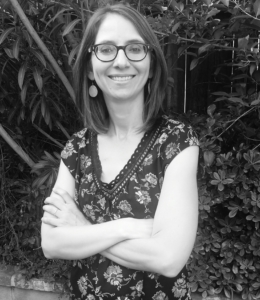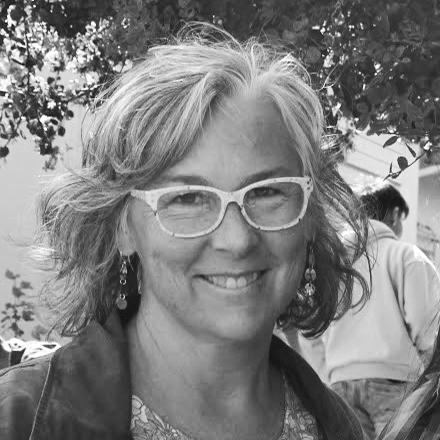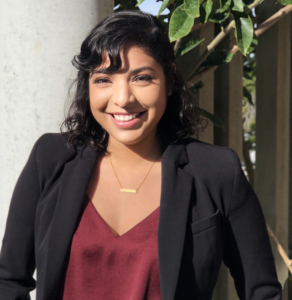MENU OF RESOURCES
Assignments
AMANDA BAUGH
— my story —
aving grown up in a white, middle-class family with parents who were part of the 1960s counter-culture, I have identified with environmentalism throughout my life.
As a kid, I wore Earth Day t-shirts, enjoyed experimenting with ideas I learned about in the book 50 Simple Things Kids Can Do to Save the Earth, and made artwork with environmental messages such as “Save the Whales!”
My parents became vegetarian when I was in high school, and I followed their path my freshman year in college. As an undergraduate I was an active member of my school’s Environmental Concerns Committee, interned with the Sierra Club, and worked part-time for a semester at an organic farm.
After college I decided to pursue a PhD in religious studies with a focus on the intersections of religion, the environment, and American culture, and I arrived at Cal State Northridge in August 2012 planning to inspire undergraduates to save the world.
My first semester at CSUN, I quickly learned that the approach to environmentalism that I had embodied throughout my life did not include the experiences or values of the diverse, immigrant, and first-generation college students who showed up in my classrooms.
While my background and life experiences marked me as the epitome of an environmental insider, my students largely perceived themselves as outsiders to the environmental movement.
To the extent that they were concerned about environmental issues, they largely perceived those as problems that must be solved by other people – people with backgrounds like my own.
In the classroom
In order to challenge my students’ preconceived notions about who or what should be included in the category of environmentalism, I organize my courses around the central paradox that American environmentalism is dominated by white people, even though communities of color express deep commitment to ecological issues.
By placing race as the central category of analysis in my class, students are able to recognize that there are many ways of enacting environmental values. They can then identify their own eco-friendly values and behaviors in a new environmentalist light, and recognize themselves as important contributors to environmental solutions.
Three main assignments that have helped my students cultivate inclusive environmental identities are:
Ecological Footprint Journals, Community-Based Research Project, and Final Video Project.
TORI DERR
— my story —
y name is Tori Derr, and I am a professor in environmental studies at CSUMB. I grew up barefoot and skinned kneed on the shores of Lake Huron. My family did not identify as environmentalists, but they cared deeply about nature. I majored in biology in college, thinking I wanted to do something with the natural world, but unsure what.
After graduating college, I joined the Peace Corps and taught in a rural school in the Gambia, West Africa. As a teacher there, I realized that the stories and books we were using, which came from England, had little to do with Gambian children’s lives. The Gambia had few resources like books but had rich cultural heritage and stories, so I asked my students to collect these stories and to generate their own narratives about what the stories meant and how their own lives were like those of their grandparents, and maybe how they had changed. Many of them shared a story called “the last elephant in the Gambia,” and spoke about how their country had changed environmentally. It was clear the students had never been asked to tell their own stories as a part of their learning, and yet these lessons were among the most exciting we had.
A few years later when I began my doctoral studies, I was interested in building on my experiences in the Gambia and studying children’s sense of place as a way to broaden the academic environmental education discourse, from a predominantly white, Eurocentric, upper middle class lens, to one that was more inclusive of diverse classes and cultures. I worked with three communities in northern New Mexico with children predominantly from Hispano families who have lived in rural NM for generations. And I also worked with parents and grandparents of these children. Working with New Mexico families emphasized the many ways that we shared values for a way of life that was largely more compatible with nature than the dominant societal paradigm. Connections to green chiles, the mountains, high elevation night skies, were all experiences we valued and shared. So while it was not my home culture, I felt very much at home there. After completing my Ph.D., I returned to New Mexico to facilitate community-based participatory research that would contribute to improved livelihoods of Southwest tribal and Spanish land grant communities.
In the Classroom
I specifically left academia after my Ph.D. to work with New Mexico communities because I felt frustrated. At the time, it seemed there was no clear place for valuing diverse community perspectives through participatory approaches within academic environmental research. When I came back to the university setting for teaching nearly 10 years later, it was only natural to me that my course materials should similarly reflect the diverse perspectives and experiences of people out there, like all the wonderful people I have worked with. But I have found this can be hard to achieve because many of the materials for teaching environmental studies still reflect the long term history of the discipline as a white, Eurocentric place of privilege. Courses that focus on social and environmental justice are the easiest places for exploring diverse environmental identities, but this is only one realm of environmental studies, so I have had to work explicitly to bring greater attention to diverse perspectives in other types of courses.
In most of my classes, I intentionally select readings so that students see through the authors and subjects that diverse people are already environmentalists, in myriad ways. I also ask students to actively engage in transformative practices within and outside their own communities. One way that I do this within the classroom is through ePortfolios, which are an online compilation of reflective writings, professional experience, and academic works. In order to develop these ePortfolios, I have students read short essays from diverse authors that get them to think about how to develop their own “personal mission” statements. These samples present diverse perspectives on their relationship to nature or to environmentalism and help students find their own voice in expressing their identity. I have seen that providing students diverse examples, often gives them permission to share their own stories. And after having taught the course now for six semesters, I can share exemplary ePortfolios from prior students who have told their honest stories, not necessarily the ones they think I or someone “out there” wants to hear. In sharing these authentic stories from their peers, I find more students are able to develop and express what their own identities are in relation to the environment. I find that students grow by literally writing their own identities.
There are many ways that I work with students to question the status quo and push for a more equitable tomorrow. The ePortofolio is one of the most self-affirming for students, and an important milestone in helping them literally construct and see themselves, through the images and webpages they build.
ANA GONZALEZ
— my story —
ey Everyone, my name is Ana Gonzalez and I am an Environmental Studies major and Chicanx Studies minor at California State University, Monterey Bay.
My environmental journey began my junior year of high school. At the time I was taking AP Environmental Science, and one of the activities we did in class was a “cookie mining” lab. The purpose of the activity was to provide an introduction to the economics of mining, but I saw it in a different way. I don’t really recall the details of the activity, but I remember that we had to dig all the chocolate chips from the cookies with paperclips and toothpicks, and we had a set amount of time and money to do so. After completing the activity my teacher told us to refill the holes with what was left from the cookie, and he continue to tell us about the importance of the mining industry. I don’t remember the rest of what he said because I was so focused on the fact that the cookie represented the planet, and that the chocolate chips represented minerals and other resources from the environment. It was shocking to think about the planet as a chocolate chipless cookie. Though it may be funny in a way, I was concerned about how our actions were affecting the environment. This was the moment I knew I wanted to pursuit some kind of environmental career.
Moving forward to college, ever since my first visit to CSUMB, I have felt a deep connection to the environment, which is way I pursued the Environmental Studies major. During my freshman orientation, my tour guide highlighted buildings on campus that were LEED (which stands for Leadership in Energy and Environmental Design) and told us how most of the building have recycled materials from the military base, and how sustainability is a hot topic among the students here at Monterey Bay. The university has allowed me to fully explore my areas of interest, find meaningful connections, and feel free to discuss these issues with my friends and peers. In addition, at CSUMB I have taken classes that allowed me to identify my identities and privileges within the environment.
Last Spring I took a class called Picturing the Environment where we watch and discussed documentaries and other films that depicted the relationship between people, communities and environments. The biggest take away for me was that the environment isn’t just at National Parks or other recreational areas but that we are the environment. I believe we have created a disconnection as a society such that many people think that in order to be fully in the environment, you have to be camping, surrounded by trees, or doing some other thing that involves being disconnected with your everyday life.
And as a Chicana, I believe this isn’t entirely true. For me, I have felt like an outsider when I think about how my family does not participate or have an active role with the environment, which I think is a tremendous part of the Mexican Culture. Mexican traditions involve a lot of connecting to the environment and the soil, seeing things grow that you have planted, and being able to enjoy the fruits of of your labor and celebrate the land. This disconnection (the American: nature being out there, away from our everyday lives, rather than the Mexican: within us and close to home) has led me to have an identity crisis where I feel I am not fully American or Mexican. I’m somewhere in between, trying to make the best of both cultures. My family has struggled to connect with the earth due to our financial status and the realities we faced living in Mexico. To my family, my studies and sustainable ideologies seem like a distant fairy tale that can only be accomplished with the luxuries of money and time.
I now believe it is my duty to educate my family and surrounding communities of the importance of our actions, and how they impact the environment, so that we all can build a more sustainable future.
Thank you.



